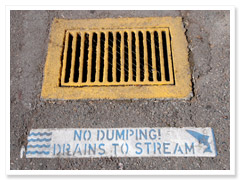Prevent Stormwater Pollution

Stormwater systems, the gutters, drains and pipes that collect run-off, flow into local rivers, lakes and coastal waters. Contamination that is allowed to enter one part of the stormwater system will flow into the waterways that we use for our gardens, food and recreation.
Businesses often use hazardous chemicals in the running of their business and are required to ensure that none of these chemicals, and other potential pollutants used in their business, are released into the stormwater system.
How to do it now!
Prepare your workplace to prevent stormwater pollution:
- Identify and assess stormwater contaminations risks at your work site and develop management plans and procedures to manage these risks.
- Educate your staff to be aware of stormwater pollution and to undertake their role in preventing stormwater pollution.
- Stormwater drains within and around the site should be stencilled with messages to alert all staff that they drain to watercourses or wetlands.
- Make sure waste bins have secure lids so that litter does not blow around and end up in the stormwater drains.
- Do not allow water to flow to stormwater drains from machinery and areas where spills might occur. Use roofing to minimise rain runoff and channels or bunds (see spill kit information) that stop polluted water getting to the stormwater drain.
- Use bunding or channels to stop rain from relatively clean areas (such as car parks and driveways) from running through dirty areas (for example work areas). Clean water that flows across a dirty area increases the amount of wastewater needing treatment, while dirty water pollutes clean areas.
- Do not let water from washing and discharge points, oil traps, filters and separators run to stormwater drains. Run them to the sewer or treatment area, according to your trade waste agreement.
- For larger sites with significant potential for stormwater pollution developing, implementing and maintaining a Environmental Management System (EMS) is recommended.
Keep your workplace clean:
- In areas where accidental spills may occur (e.g. loading/unloading areas), ensure that appropriate spill response equipment is available and readily accessible at all times.
- A clean site is all part of the job for all staff. Give floor and outside areas special attention.
- Chemicals, paints, oils and any other material that could wash off site must be correctly stored or protected to stop them getting into the stormwater drains.
- Wash vehicles, engines and machinery parts in areas that drain to proper waste facilities.
- Keep machinery maintained, to cut the risk of leaks - keep regularly cleaned so that any leaks can be seen and attended to quickly.
- Use spill trays under work areas where a spill could occur.
- Control airborne sprays so they cannot land on surfaces where rain will wash them down the drain.
- Minimise the waste stored on your site. Check all containers regularly for leaks and safe storage.
Minimise the risk of an accident:
- Safe handling and storage to prevent pollution is part of the job for all staff.
- Make a plan to deal with spills. Involve staff in this planning to give them ownership. Do not hose spills down the drain – if the spill gets into the stormwater system you may be prosecuted for pollution and pay a hefty fine.
- Get a spill kit and train staff to use it. A spill kit should include :
- Protective clothing including face masks and gloves.
- Absorbing and cleaning agents – sand, sawdust, absorbent pads/pellets, kitty litter, mops and rags.
- Portable bunding (sausage barriers similar to sandbags) to direct spills or wash–water away from drains to clean up areas.
- Shovels brooms and dustpans to sweep up solid and powder spills.
- Use alternative materials for cleaning, coating, lubrication, and other production processes to prevent the generation of hazardous wastes and minimise the risk of stormwater being contaminated by these wastes.
Why is this action important?
By implementing thorough Stromwater management practices, organisations reduce the risk to stormwater and groundwater quality that is posed by their business activities. Stormwater management practices improve workplace safety while lowering the risk of the organization breaching environmental legislation and the cost of subsequently being prosecuted. These practices limit the introduction of chemicals and other pollutants to our waterways, lives and bodies.
